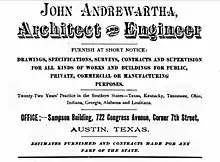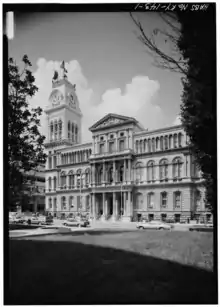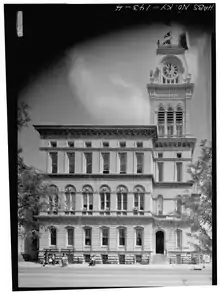John Andrewartha
John Andrewartha (25 August 1839 – 7 November 1916) was an English architect and civil engineer.


Early life and education
John Andrewartha was born at Falmouth, Cornwall, the son of William Guy and Sarah Elizabeth Andrewartha. He trained as an engineer in the Royal Navy.[1]
Career

Andrewartha began working in the United States in 1865, first based in Louisville, Kentucky, and after 1881 in Austin, Texas. In Kentucky his firm won a design contest in 1866 for the Louisville City Hall.[2] The city's Courier-Journal Building was also his design; it burned down in 1979.[3] Andrewartha also designed the original entrance lodge, stables, clubhouse, and other structures at Churchill Downs, though they have all since been replaced.[4]
In 1872, Andrewartha and two others (the contractor and the site foreman) were charged with manslaughter after the fatal collapse of the Pettit Building in Louisville.[5] But in late 1873, he was listed as the architect for the building of the Fourth Kentucky Lunatic Asylum project.[6]
Among his varied completed projects in Texas were the Austin City-County Hospital (1884), the first public hospital in Texas; the St. John's Home for Negro Orphans in East Austin (1911), the original Montopolis Bridge over the Colorado River[7] (which was washed away in a 1935 flood), and Austin residences such as the Henry Hirschfeld House, which is on the National Register of Historic Places.[1]
Personal life
Andrewartha married Jemima Louisa Whillier on 11 June 1861 in Alverstoke, Hampshire, England. They had twelve children together; seven of their children lived to adulthood. John was widowed when Jemima died in May 1915 at their home in Austin, Texas;[8] he died the following year, aged 77 years.[9]
References
- Christopher Long, "John Andrewartha" in Handbook of Texas Online (Texas State Historical Association 2010).
- David Dominé, Old Louisville: Exuberant, Elegant, and Alive (University of Georgia Press 2013): 40. ISBN 9780932958297
- Elizabeth Fitzpatrick "Penny" Jones, "Architecture" in John E. Kleber, Encyclopedia of Louisville (University Press of Kentucky 2015): 45. ISBN 9780813149745
- Gregory Luhan, Dennis Domer, and David Mohoney, The Louisville Guide (Princeton Architectural Press 2004): 257. ISBN 9781568984513
- "The Louisville Horror" Nashville Union and American (13 October 1872): 1. via Newspapers.com

- Journal of the Kentucky General Assembly and Senate (19 January 1876): 160.
- "Specious Pleading of the Bridge Company" Austin Weekly Statesman (9 May 1889): 2. via Newspapers.com

- "The Austin [Texas] American". 16 May 1915.
- "Biographies of Oakwood Cemetery Residents" Save Austin's Cemeteries website; The Austin [Texas] American-Statesman, 7 November 1916https://www.newspapers.com/clip/22230397/john_andrewartha_obituary/
